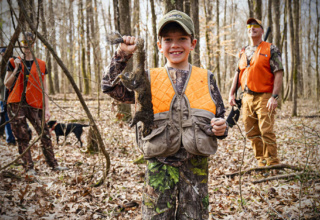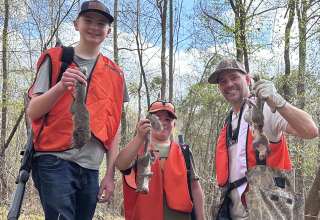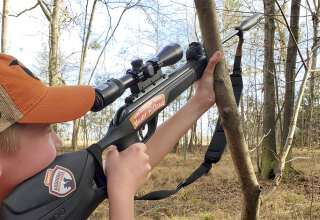Want to start hunting? Here’s how to take that first step.
by Rob Reaser
Here’s an interesting fact to ponder: all hunters are shooters but not all shooters are hunters.
How you align yourself with one or both camps probably depends on how you entered the world of shooting. Most hunters got into the game as a way of life, being introduced at a young age by family members. This lifestyle began by being introduced to firearm shooting and safety, followed by years of in-the-field mentoring, where the new hunter learned the ways of game animals and the complete field-to-table process.
The last 15 or 20 years, though, have seen an untold number of people enter the shooting realm without taking the traditional path. Hailing from suburban or urban locales, they began shooting for self-defense or recreation and gradually moved on to competition shooting or other venues. Many of these shooters are curious about hunting and would like to start as a means of expanding their firearm interest and recreation, or simply to enjoy the benefits of eating wild game that they have procured through their own efforts.
The challenge for many of these folks (and you may be one of them) is taking that first step. What do you need to hunt? Where do you go? How do you learn the skills required? What do you do with an animal after you harvest it?
That’s a lot to figure out if you don’t have someone who’s able to show you the ropes. If that sounds like you, we want to help get you started, and the easiest way to do that is to go squirrel hunting.
Nearly every lifelong hunter began by hunting squirrels. Squirrels are everywhere across North America and in great numbers. They can be challenging from a hunting perspective, yet they are the easiest game animal to bag. Furthermore, being in the woods and hunting squirrels will expose the beginning hunter to the nature and habits of other animals, such as deer and turkey. Squirrels are also healthy and tasty table fare. My favorite way of eating them is in a pot pie. They are also terrific when fried and served with mashed potatoes and a gravy made from the grease you cook them in. Those are just a couple of popular options.
For the optimal in squirrel hunting sport, nothing beats a rimfire rifle or a quality .22-caliber air rifle. This method utilizes the skills you’ve already developed as a shooter and is a pile of fun. It’s also cheap fun, since a suitable bolt-action or semi-auto .22LR rimfire or pellet rifle can be had for under $300 and ammo is plentiful and inexpensive.
Early fall, from now through October, is the best time to hunt squirrels. The weather is generally mild in most areas of the country, and there is enough foliage still on the trees to make stalking them fairly easy.
As for where to hunt squirrels, state-owned lands are usually an easy bet. Just check your state game regulations for nearby wildlife management areas. A lot of private landowners also have no problem letting squirrel hunters on their property (although that usually changes when the subject is deer hunting). Just zero in on areas with plenty of oak or hickory trees and you’ll be in business.
Essential Squirrel Gear
It doesn’t take a lot to hunt squirrels. We’ve already mentioned rimfire and pellet rifles in .22 caliber as top choices, but shotguns are also fine—preferably something in the .410 to 16-gauge realm. We don’t recommend 12-gauge shotguns because they can really bugger up a squirrel should you get on one at close range. This year, we’ve been using a GAMO Swarm Fusion 10X Gen2 with open sights. Shooting open sights is fun and sharpens our marksmanship skills, and the fast-loading 10X technology makes any follow-up shots lightning quick.
You’ll definitely want a game vest or some sort of pouch to carry your squirrels in. For this, we’ve found nothing better than the Upland Game Vest X from ALPS OutdoorZ. This is a harness-style vest that comfortably distributes the load across the shoulders and waist (unlike conventional game vests), and comes with multiple zippered pockets for water, snacks, ammunition, and other essential gear. It is even hydration compatible.
Although it may seem like overkill to some folks, we find a good pair of binoculars to be essential equipment on any hunt…even for squirrels. Good glass helps in locating squirrels that may be hiding in a limb fork or sitting motionless while gnawing on a nut. Binos also help to locate squirrels at a distance when the leaves are down, allowing you to plan a stalk. For this, we like the Vortex Optics Diamondbacks in 8×42. These are good glass at great prices that work well for other hunting or shooting application, and their warranty is the best in the business.
Finally, you’re going to need a good knife to clean those squirrels (we’ll show you how to do that next). For this, we like a small-bladed knife with a prominent curvature along the cutting edge, which helps in cutting through the squirrel’s tough hide. The Bear & Son Stag Delrin Upswept Skinner is perfect for the job. The robust handle provides ample grip and good blade control for the delicate skinning work, and the leather sheath wears comfortably on the belt, so it is always ready.
How to Prepare a Squirrel for the Pot
One of the most difficult barriers for the first-time hunter is knowing what to do with an animal once it is in the proverbial bag. If you’ve never field-dressed, skinned, or butchered an animal before or never seen someone do it, the process can be daunting. This is why squirrels are a great on-ramp species for hunting larger game animals down the road, as the process is similar in many aspects for any species. There are, however, good ways to prepare a squirrel and really bad ways to do it (and, boy, have we seen some bad ways!). We’re going to show you the good way…
Grasp the squirrel by the back legs and pluck the hair from the hide, beginning at the base of the tail and working your way in front of the rear leg and down to the belly. Repeat for the other side. This allows you to cut the hide for skin removal without getting hair all over the meat (the biggest challenge when cleaning squirrels).
Starting at the base of the tail, cut the skin down to the meat, being careful to avoid cutting into the meat.
Continue to cut the skin along the area where you removed the hair all the way down to the belly. Don’t try to cut the skin across the belly, just make the cut down to the belly.
Carefully cut the base of the tail by working the knife between the tail joint, as seen here. Do not cut off the tail! You will be using the tail to remove the skin.
While holding the rear legs, step on the base of the tail and pull up on the squirrel.
As you pull up on the squirrel, the skin will separate at the belly.
Work you fingers between the skin and the exposed front legs. Pull the skin away from the legs until you’ve exposed the ankles and stop. If you continue to pull the skin off the foot, you will probably rip your finger on the sharp claws. We’ve made that mistake before, and trust us, you don’t want to do that!
Do the same for the rear legs, stopping when the skin exposes the ankles.
A pair of utility shears are perfect for cutting the feet off at the ankles. Lacking shears, you can use a small hatchet and a wood block backer. Shears, though, are the best tool to use.
With the feet removed, take your knife and cut around the neck until you hit the spine. At this point, grasp the head in one hand and the body in the other and twist the head off.
Slide your knife beneath the center of the rib cage and pull up to cut through the ribs and expose the upper chest cavity. Reach up into the cavity, grasp the trachea and esophagus, and pull the entrails out in one motion.
To separate the rear legs, cut around the top of the hip, aiming for the hip socket (seen here). It will take a few times before you get this part down, but once you get it, you got it. The idea here is to remove the rear leg with as much meat as possible while separating it from the hip girdle. Continue by removing the front legs.
Larger squirrels have plenty of usable meat along the back between the rib cage and the spine. Use your knife to remove as much as you can.
Squirrels deliver a lot of meat, and it only takes a few to make a meal for the entire family. It’s clean, lean, and quite tasty, and there are plenty of good online recipes for preparing squirrels. Find one you like and enjoy!
































